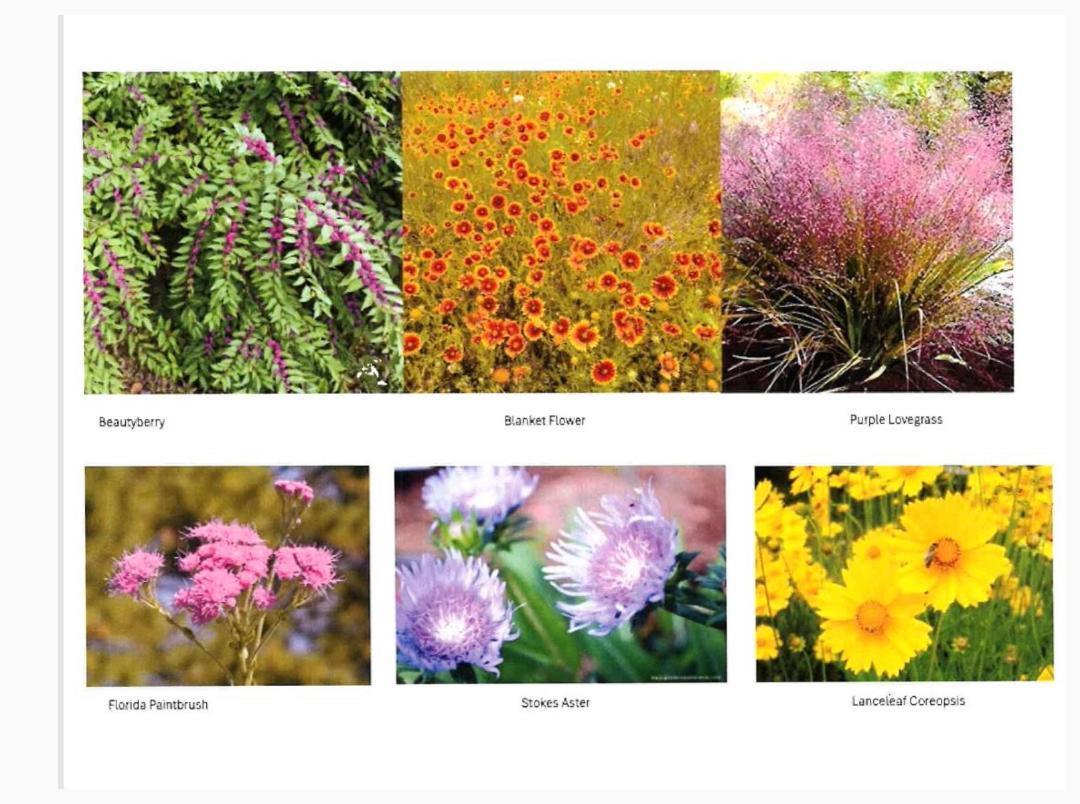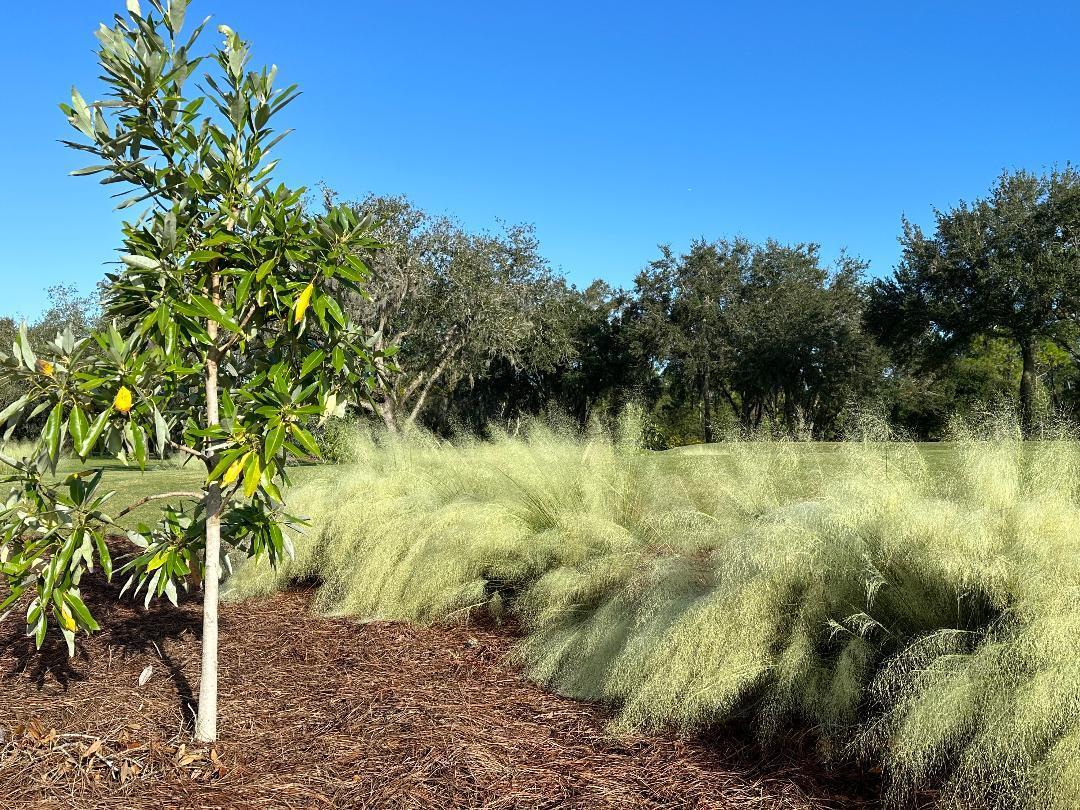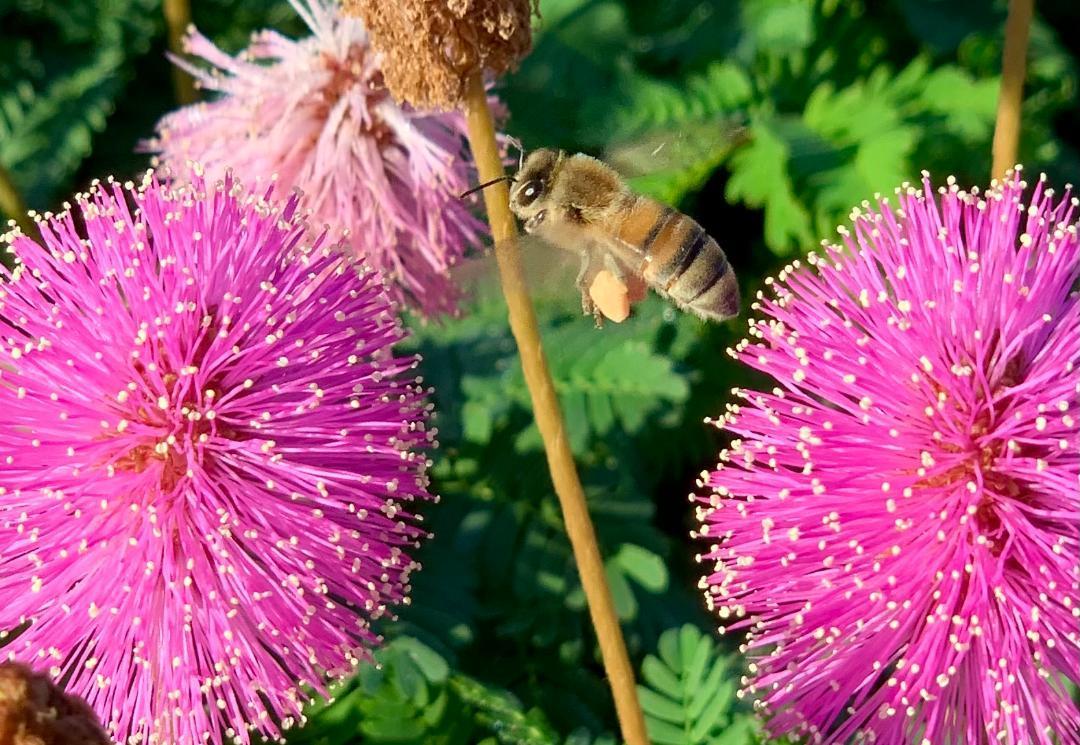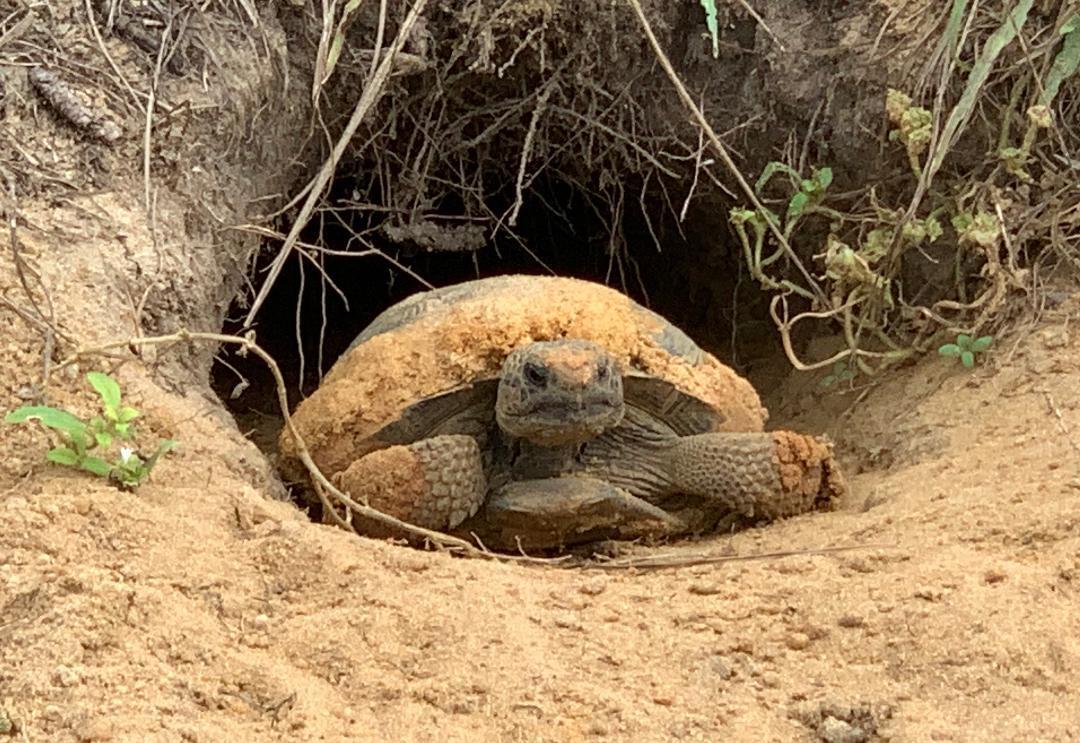Acer to Zamia
35+ Native Florida Plants to Revive our Ecosystems









Bees of all kinds move pollen from plant to plant, ensuring that the subsequent fruit has viable seeds with genetic diversity.



Birds are the great planters - they eat berries and deposit the seeds back to the earth, contributing to the natural perpetual revegetation of our planet


Butterfly and moth larvae, caterpillars of all species, are high in protein and fat and are the most nourishing and important food for the growth and development of baby birds.
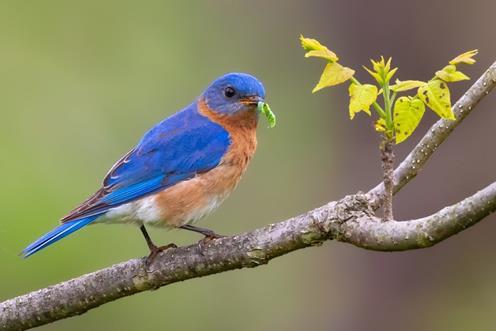
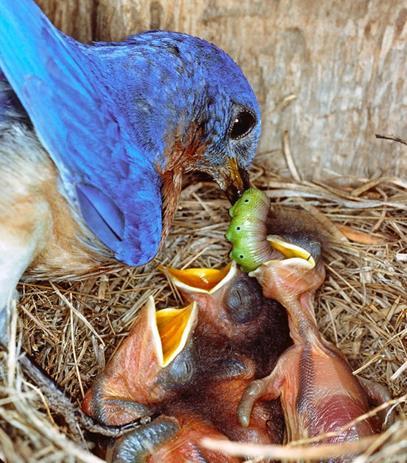
This Monarch (below) is depositing eggs on the Monarch host plant, a Milkweed. When the larvae emerge, they start feeding on the leaves, and as they grow, the likelihood increases that a bird will pick them up and take them back to the nest to feed their babies. The synergy between bees, birds, and butterflies is critical to the success of our ecosystems, and we can help!
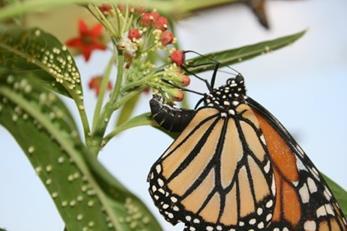


We now know how critical the bees, birds, and butterflies are, but the system relies on the native flowering plants that have coexisted synergistically here in Florida for millenia. Without the host plants, the system breaks down. With the right plants, ecosystems are revived!




It’s important to know that not all plants support all pollinators. There are several plants that need specific pollinators and several pollinators that need specific plants. One common example is that Monarch Butterflies need Milkweed as a larval host plant. While they can gather nectar from several other wildflowers, like Mistflower, Echinacea, etc., they need the Milkweed as their larval host.




Another example that’s even more specialized is the connection between the Zebra Longwing Butterfly and the Corky-stem Passion Vine. It is even further specialized in the fact that the vine must be in at least partial shade in order for the Zebra Longwing to use it.
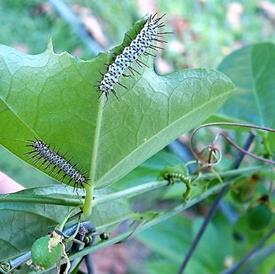







LandscapeValue:
Hardy Range:
DESCRIPTION

Provides shade in summer, sun in winter. Provides first pollen in winter for honey bees and native bees, host plant to Cecropia Silkmoth,Imperial Moth, Polyphemus Moth, and Rosy Maple Moth
3b to 9
Mature Height: 50 - 60’
GrowthRate: medium to fast

Mature Spread: 25 - 35’
Form: upright, oval with age
Persistence: deciduous
Salttolerance: low
Exposure: partial to full sun
Soil:
moist sites are best
Canreplace: Chinese Elm and Winged Elm

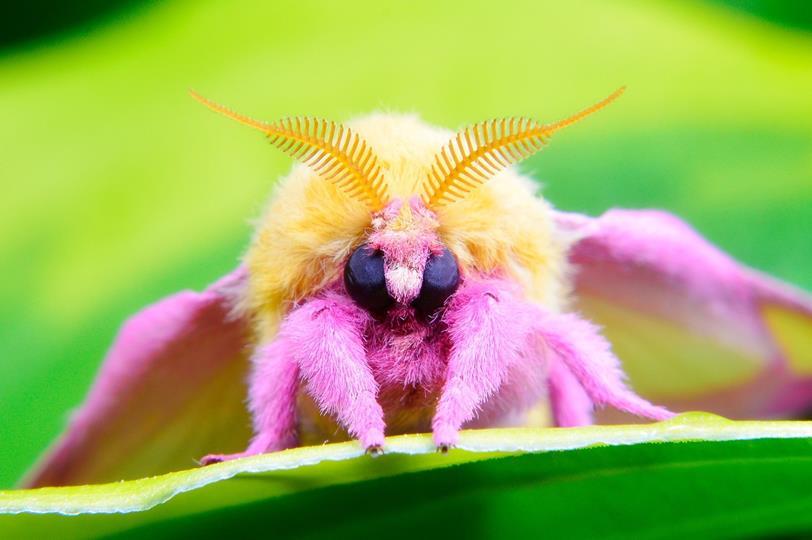

LandscapeValue:
Hardiness Range:
DESCRIPTION
A native holly that will provide substantial shade on smaller lots, attractive fruit sustains birds and flowers sustain honey bees and native bees with pollen and nectar
7 to 9
Mature Height: 30 - 40’
GrowthRate: medium
Mature Spread: 15 - 20’
Form: oval, pyramidal
Persistence: evergreen
Salttolerance: medium
Exposure: partial to full sun
Soil:
Clay, sand, loam; slightly alkaline, acidic; extended flooding; welldrained
Canreplace: Nellie Stevens Holly

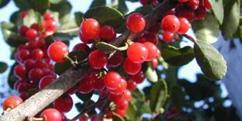
LandscapeValue:
Hardiness Range:
Interesting form, colorful fruit,flowers and fruit sustain bees and birds, leaves can be used to make tea, host plant to Henry’s Elfin
Butterfly
7 to 10
DESCRIPTION
Mature Height: 15 - 30’
GrowthRate: moderate to fast
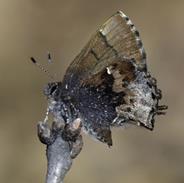
Persistence: evergreen
Mature Spread: 6- 12’
Form: myriad, weeping, upright, columnar etc.
Salttolerance: high
Exposure:full sun, partial sun or partial shade
Soil:
clay; loam; sand; acidic; alkaline; well-drained, extended flooding
Canreplace: Eugenia spp.




LandscapeValue: Fast growing shade, maintains symmetrical pyramidal crown, outstanding multicolor fall foliage, many worthy cultivars, seeds provide food for wildlife, host plant for Luna and Promethea moths
Hardiness Zone:
DESCRIPTION

Mature Height: 60 - 75’
GrowthRate: moderate to fast
Persistence: deciduous
Exposure:full sun; partial shade
Soil: 5 to 9
Deep,moist slightly acid soil
Canreplace: River Birch,Sycamore
Mature Spread: 35 - 40’’
Form: broad, rounded pyramid
Salttolerance: moderate

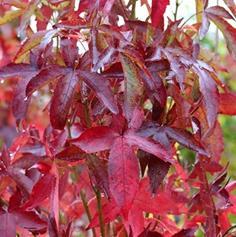
LandscapeValue:
Hardiness Zone:
DESCRIPTION
Very tight columnar form makes architectural statement, as adaptable as the straight species American Sweetgum, host plant for Luna and Promethea moths
5 to 9
Mature Height: 35 - 45’
GrowthRate: fast
Mature Spread: 6’
Form: columnar
Persistence: deciduous
Salttolerance: moderate
Exposure:full sun; partial shade
Soil:
Deep,moist slightly acid soil
Canreplace: Italian Cypress Can replace

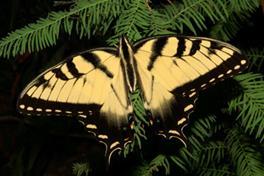

LandscapeValue:
Hardiness Range:
DESCRIPTION
Underside of foliage is attractive silver color,extremely fragrant flowers,pyramidal shape when young, tolerates wet soil conditions, host plant to Southern Tiger Swallowtail Butterfly
5a to 10a
Mature Height: 35 - 50’
GrowthRate: fast
Persistence: evergreen
Mature Spread: 20 - 30’
Form: pyramidal when young
Salttolerance: low
Exposure: partial to full sun
Soil:
Requires acidic soil; extended flooding; well-drained
Canreplace:ce: Flowering Dogwood, White Geiger



LandscapeValue: Versatile plant can be large shrub or small tree,fragrant white flowers, attractive red berries, smooth exfoliating bark, 4-season interest and great pollinator and bird plant
Hardiness Range:
DESCRIPTION
Mature Height: 20 - 30’
GrowthRate: slow
Mature Spread: 15 - 20’’
Form: rounded oval
Persistence: evergreen
Exposure: full sun to shade
Soil: 9B to 11
Well-drained; loamy, sandy or clay
Salttolerance: moderate
Canreplace: Eugenia spp., Sweet Viburnum



LandscapeValue:
Hardiness Range:

Prunus is a keystone genus for sustaining wildlife, profuse white flowers in late winter sustain pollinators, one-inch-long edible plums sustain wildlife, host plant to Eastern Tiger Swallowtail
– 11
DESCRIPTION
Mature Height: 12 - 20’
GrowthRate: fast
Persistence: deciduous
Mature Spread: 12 - 20’ ’
Form: short, broad head
Salttolerance: low
Exposure: full sun, part sun, part shade
Soil: widely adaptable
Canreplace: Flowering Dogwood, Eastern Redbud

THE iconic tree of the south, grows to massive proportions, with horizontal branches sweeping down to the ground, then ascending upward, provides ecologicalservices almost beyond measure, exceedingly strong and storm resistant, for large open spaces only, as roots will damage pavement and other structures

Mature Height: 40 - 80’
Mature Spread: 60 - 100’
Form: broad spreading oval
Salttolerance: high
GrowthRate: medium
Persistence: evergreen Exposure: full sun
Soil:
Highly adaptable
Canreplace: Laurel Oak, Sycamore
Hardiness Range:
8 to 10



LandscapeValue:
Hardiness Range:
Fast-growing tree gets very tall and broad with age, huge buttressed trunks are impressive, can have intense fall color, and dazzling spring color when leafing-out, helps prevent erosion on river edges, and are used by frogs, toads, and salamanders as breeding grounds, larvalhost of Baldcypress Sphinx Moth
4 to 10
DESCRIPTION
Mature Height: 50 - 70’
GrowthRate: fast
Persistence: deciduous
Exposure: full sun
Soil:
Mature Spread: 25’
Form: pyramidal, upright, erect
Salttolerance: medium
Acidic; dry, loamy, moist,sandy, well drained soils, wet clay soils, submerged
Canreplace: River Birch,Sycamore
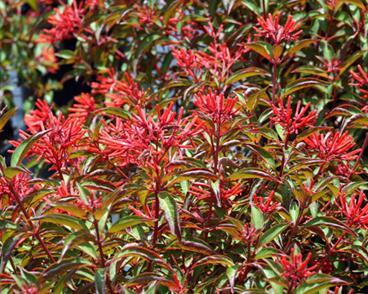

LandscapeValue:
Shorter internodes result in a neater, more compact and showy presentation, flowers are a richer red than the species and provide nectar to sustain butterflies, hummingbirds, and bumblebees, larval host to Pluto SphinxMoth
Hardiness Range:
DESCRIPTION

Mature Height: 6 - 8’
GrowthRate: fast
Persistence: semi-evergreen
Exposure: full sun to partial shade
Soil: 9 to 11
Mature Spread: 6 - 8’
Form: broad spreading rounded mound
Salttolerance: poor
moist, acidic, alkaline, sand, loam, clay
Canreplace: Non native Hamelia, Justicia Orange Plume



LandscapeValue:
Hardiness Range:
DESCRIPTION
Excellent plant for shady areas with shiny foliage, white flowers in spring and summer, and attractive red fruit, cultivar Little Psycho is more compact for smaller spaces, sustains bees and birds,and sustains the Coffee loving Pyrausta moth.
Mature Height: 4 - 10’
Mature Spread: 4 - 8’
GrowthRate: moderate
Form: round
Persistence: evergreen
Exposure: partial shade,partial sun
Soil: 10 to 11
clay, sand, loam, alkaline, acidic
Salttolerance: poor


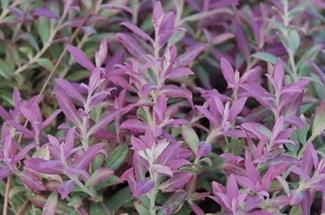
LandscapeValue: Outstanding foliage color, ranging from pink blush to skyblue, pink or white bell-shaped flowers sustain bees edible berries sustain birds and mammals, a four season native shrub
Hardiness Range:
DESCRIPTION
Mature Height: 4 - 6’
GrowthRate: medium
Persistence: evergreen
Soil: 9A to 11
Mature Spread: colonizes by rhizomes
Form: rounded
Salttolerance: poor
Exposure: partial to full sun
sandy, loamy, clay, acidic, neutral and basic alkaline soils
Canreplace: Texas Sage, Snow on the Mountain


LandscapeValue:
All the attributes and benefits to wildlife of Viburnum obovatum available in a tree form,very fine-textured foliage, neat and stately small tree for the landscape, host plant for the Spring Azure Butterfly
Hardiness Range:
DESCRIPTION
Mature Height: 25’
GrowthRate: moderate
Persistence: evergreen
Exposure: full sun to partial shade
Soil: 7 to 10
Mature Spread: 10 - 15’
Form: rounded
Salttolerance: low
acidic, well drained to intermittently wet
Canreplace: Flowering Dogwood, White Fringetree
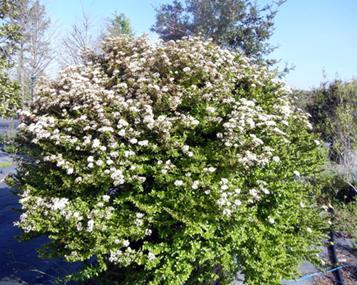

LandscapeValue:
Hardiness Range:
Adaptable evergreen V.o. cultivar that is slightly smaller than the species, same profuse flowering and fruit, attracts butterflies, is a larval host for the Spring Azure Butterfly, and fruit sustains birds and mammals
7 to 10
DESCRIPTION
Mature Height: 10 - 12’
Mature Spread: 8 - 10’
GrowthRate: medium
Persistence: evergreen
Exposure: partial to full sun
Form: rounded
Salttolerance: low
Soil: acidic, well drained to intermittently wet
Canreplace: Wax Myrtle, Dwarf Burford Holly


LandscapeValue:
Hardiness Range:
DESCRIPTION
An outstanding V.o. cultivar that stays compact and blooms profusely,providing the same benefits to wildlife as the species
Mature Height: 5 - 6’
GrowthRate: slow - moderate
Persistence: evergreen
Exposure: full sun
Soil: 7 to 10
Mature Spread: 6 - 7’
Form: round
Salttolerance: poor
clay; loam; sand; acidic; alkaline; well-drained
Canreplace: Sweet Viburnum, Dwarf Burford Holly
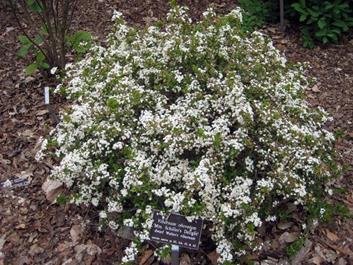

LandscapeValue:
Hardiness Range:
The smallest of the Walter’s Viburnum cultivars, stays very compact, and almost eliminates the need for pruning, making it very sustainable in many ways
DESCRIPTION
Mature Height: 3 - 4’
GrowthRate: slow
Persistence: evergreen
Soil: 7 to 10
Mature Spread: 4 - 5’
Form: rounded mound
Salttolerance: poor
Exposure: partial to full sun
clay; loam; sand; acidic; alkaline; well-drained
Canreplace: Indian Hawthorne,Natal Plum



LandscapeValue: Coarse texture, and silvery color is very eye-catching, larval host for Palmetto Skipper and Monk butterflies, is a major honey plant in Florida, honey is relatively dark with a mellow,earthy flavor, sustains bees
Hardiness Range:
DESCRIPTION 7 to 11
Mature Height: 3 - 5’

GrowthRate: fast
Mature Spread: 4 - 5’
Form: upright; arching vase-shape when in flower
Persistence: semi-evergreen
Exposure: full sun
Salttolerance: moderate
Soil: Flooding, acidic, alkaline, sand, loam, clay


LandscapeValue:
Hardiness Range:
Durable and adaptable native grass that provides seeds for birds and invertebrates and is the larval host for the Zabulon Skipper Butterfly
8 to 11
DESCRIPTION
Mature Height: 3 - 4’
GrowthRate: moderate
Mature Spread: 4 - 6’
Form: rounded
Persistence: semi - evergreen
Salttolerance: poor
Exposure: partial shade to full sun
Soil: sandy, loamy, clay, acidic, flooding,acidic, slightly alkaline
Canreplace: Fountain Grass, Maiden Grass

LandscapeValue:
Hardiness Range:
Durable and adaptable native grass that provides seeds for birds and invertebrates and is the larval host for the Zabulon Skipper Butterfly
DESCRIPTION 8 to 11
Mature Height: 3 - 4’

Mature Spread: 4 - 6’
GrowthRate: moderate
Form: rounded
Persistence: semi - evergreen
Salttolerance: poor
Exposure: partial shade to full sun
Soil: sandy, loamy, clay, acidic, flooding,acidic, slightly alkaline
Canreplace: Fountain Grass, Maiden Grass

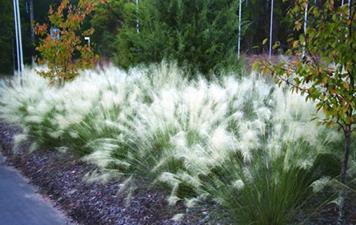
LandscapeValue: Highly adaptable and ornamental native grass, stunning airy purplish (or white) flowers in the fall, that sway in the slightest breeze, adding movement to the landscape, provides seeds for birds, and cover for small birds and mammals
Hardiness Range:
DESCRIPTION 7 to 11
Mature Height: 3 - 5’
GrowthRate: fast
Mature Spread: 4 - 5’
Form: upright; arching vase-shape when in flower
Persistence: semi-evergreen
Exposure: full sun
Salttolerance: moderate
Soil: Flooding, acidic, alkaline, sand, loam, clay
Canreplace: Fountain Grass, Maiden Grass
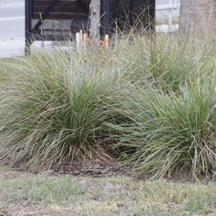

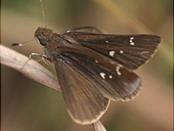
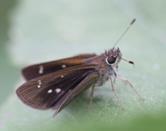
LandscapeValue:
Hardiness Range:
Durable and adaptable native grass that provides seeds for birds and deer, and is the larval host for the Clouded Skipper and Three-Spotted Skipper,
DESCRIPTION 8 to 11
Mature Height: 3 - 4’
GrowthRate: moderate
Mature Spread: 4 - 6’
Form: rounded
Persistence: semi - evergreen
Salttolerance: poor
Exposure: partial shade to full sun
Soil: sandy, loamy, clay, acidic, flooding,acidic, slightly alkaline
Canreplace: Fountain Grass, Maiden Grass

LandscapeValue:
Hardiness Range:
Outstanding plant for spring/early summer color, will self-sow, but not aggressively, very attractive to honey bees and other pollinators, foliage is very cold tolerant, providing a clean look in winter
DESCRIPTION
Mature Height: 1 - 3’
GrowthRate: fast
Soil: 8 to 11
Mature Spread: 1- 2’
Form: mounding foliage, upright flowers
Persistence: evergreen SaltTolerance: Unknown
Sandy to sandy loam
Exposure: full sun
Canreplace: Non-native FL Bedding Plants

LandscapeValue: Tough drought-tolerant creeping groundcover with stunning pink powerderpuff flowers, provides nectar and pollen for bees, will lose foliage in freezing temperatures or after heavy frost, but will recover with warmer temperatures, host plant for Little Sulphur Butterfly. Gopher Tortoises eat the flowers.
Hardiness Range:
8A to 10B


DESCRIPTION
Mature Height: 8”
GrowthRate: medium
Mature Spread: Indeterminate
Form: creeping, upright foliage and flowers
Persistence: deciduous
Salttolerance: moderate
Exposure: full sun, minimal shade
Soil:
Dry to moist, well-drained sandy soils
Canreplace: Conventional turf, non-native groundcovers


LandscapeValue:
Hardy Range:
Another outstanding wildflower with regards to the array of pollinators served, unique flower structure, responds very wellto pruning, foliage is aromatic, host plant for the Raspberry Pyrausta
Butterfly
4 to 9
DESCRIPTION

Mature Height: 1 - 3’
GrowthRate: fast
Persistence: deciduous
Exposure: partial to full sun
Mature Spread: 2 - 4’
Form: spreading
Salttolerance: unknown
Soil: sand, loam, clay, acidic, slightly alkaline
Canreplace: Non-native FL Bedding Plants


LandscapeValue: Alternative to turfgrass lawn, will take light foottraffic, outstanding services to pollinators, host plant for the Phaon Crescent, White Peacock, and CommonBuckeye Butterflies, nectar sustains many species of bees and butterflies, severe cold can cause some die-back
Hardiness Range:
DESCRIPTION


Mature Height: 6” - 9”
GrowthRate: fast
Persistence: evergreen
Exposure: partial to full sun
Soil: 9A to 11
Mature Spread: Indeterminate
Form: upright, spreading laterally
SaltTolerance: moderate
sandy, loamy, clay, acidic, neutral and basic alkaline soils
Canreplace: Conventional turf, non-native groundcovers
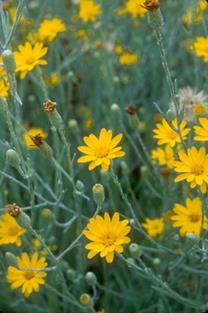

LandscapeValue: A very dynamic native perennial, looks like a grass in juvenile stage, with stunning iridescent foliage before sending up hundreds of flower stalks, appearance supports a mediterranean look, sustains native bees and butterflies, thrives in dry areas
Hardiness Range:
DESCRIPTION
Mature Height: 25 - 35’
GrowthRate: medium
Soil: 9A to 11
Mature Spread: 30 - 40’
Form: rounded
Persistence: evergreen
SaltTolerance: poor
sandy, loamy, clay, acidic, neutral and basic alkaline soils
Exposure: partial to full sun
Canreplace: Non-native FL Bedding Plants



LandscapeValue: Tough drought-tolerant plant that blooms continuously unless kept too wet, good companion with other wildflowers like Tropical Sage and Mistflower, handles cold weather very well, a champion for wildlife services, sustaining bees, birds, and butterflies, host for SmallWavylined Emerald Moth and Silvery Checkerspot
Hardiness Range:
DESCRIPTION
Mature Height: 1 - 2’
GrowthRate: medium
Soil: 8A to 11B
Mature Spread: 1 - 2’
Form: upright
Persistence: herbaceous SaltTolerance: high
Well-drained sandy soils
Exposure: full sun
Canreplace: Non-native FL Bedding Plants
Soil:

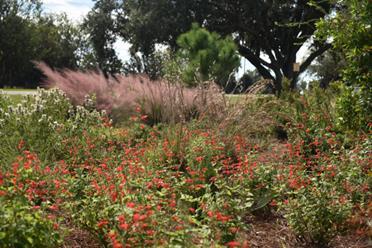
LandscapeValue:
Perhaps the most reliable and one of the showiest wildflowers in Florida, can bloom year-round in the absence of a heavy frost or hard freeze, sustains an amazing array of native pollinators
Hardiness Range:
DESCRIPTION 7 to 11
Mature Height: 2 - 4’
GrowthRate: fast
Persistence: semi-evergreen
Exposure: partial to full sun
Mature Spread: 2’
Form: upright
Salttolerance: unknown
Soil: Acidic, alkaline, sand, loam, clay, occasionally wet
Canreplace: Non-FL-native bedding plants

LandscapeValue: Durable and dependable perennial blooms almost year-round, flowers are large and stems take on shades of burgundy-brown that are very attractive, sustains birds, bees, and butterflies
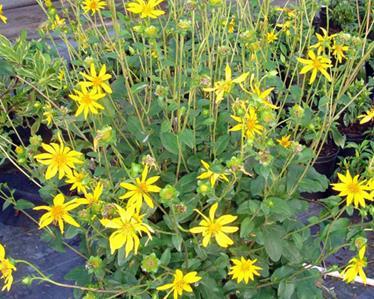
Hardiness Range:
DESCRIPTION
Mature Height: 2 - 5’
GrowthRate: medium
Persistence: semi-evergreen
Exposure: partial to full sun
Soil: 8A to 10B
Mature Spread: 1 - 2’
Form: rounded
SaltTolerance: par
Moderately dry to moist well-drained soils
Canreplace: Non-native FL Bedding Plants



LandscapeValue:
Hardiness Range:
Outstanding mounding shrub, blue flowering spikes on ascending branches, great nectar source for butterflies, host plant for the TropicalBuckeye, Clouded Skipper, Gulf Fritillary, Red Admiral, and Julia
DESCRIPTION


Mature Height: 1 - 3’
GrowthRate: medium
Persistence: semi-evergreen
Mature Spread: 5’

Form: rounded mound, spreading
SaltTolerance: unknown
Exposure: partial to full sun
Soil: 9B to 11A
sandy, loamy, clay, neutral and basic alkaline soils
Canreplace: Non-native FL Bedding Plants, Blue Daze


LandscapeValue:
Hardiness Range:
DESCRIPTION
Beautiful blue-lilac blooms of great detail with sturdy stems, perennial plant can be propagated by dividing mature plants, sustains butterflies and bees, generally deer-resistant
Mature Height: 1- 2’
GrowthRate: medium
Persistence: evergreen
Exposure: partial to full sun
sandy, acidic soils
Soil: 8 to 11
Mature Spread: 1 - 2’
Form: Mounded basal rosette
SaltTolerance: Poor
Canreplace: Non-native FL Bedding Plants


LandscapeValue: Well-adapted native FL cycad, slow growing and requires little to no pruning making it very sustainable, interesting fern- like structure, attractive seed cluster, important host plant to the Atala butterfly, which was nearly extinct just a few years ago
Hardiness Range:
DESCRIPTION
8B to 11
Mature Height: 3 - 4’
GrowthRate: slow
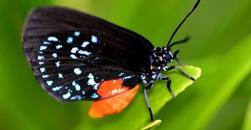
Persistence: evergreens
Exposure: full sun to full shade
Soil:
Mature Spread: 4 - 5’
Form: broad spreading mound
Salttolerance: high
Dry to moist, well-drained sandy or calcareous soils
Canreplace: Indian Hawthorne,Pittosporum,Green Schefflera








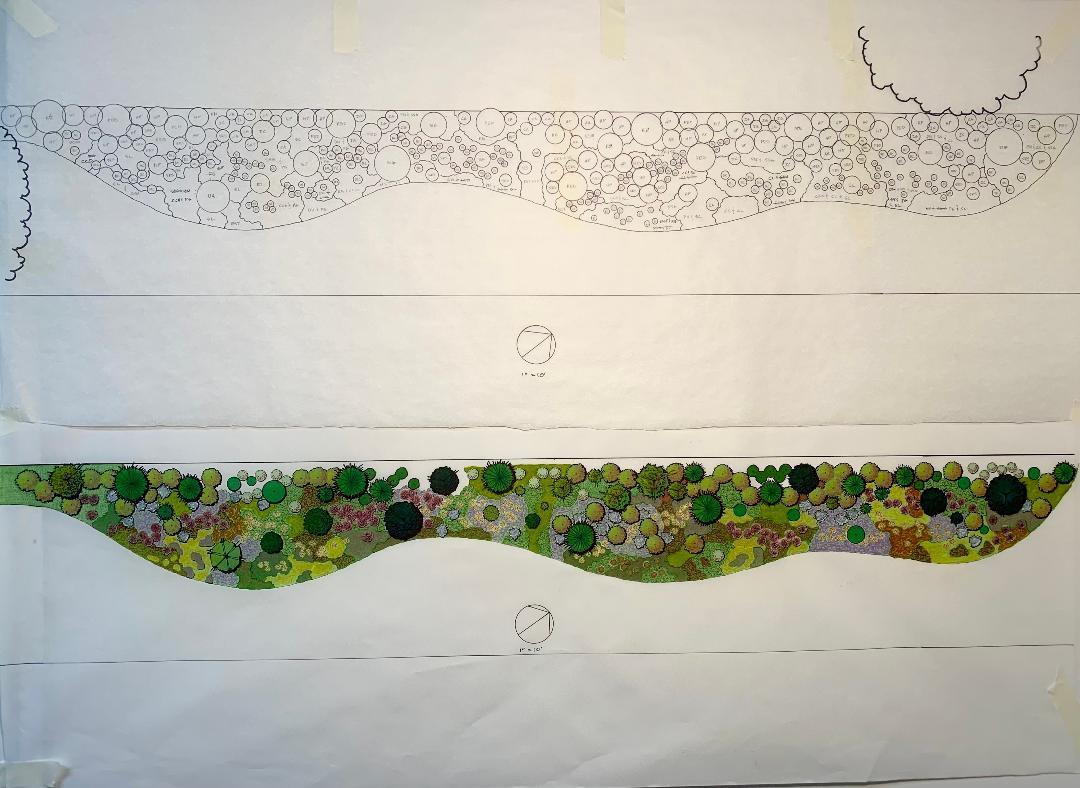






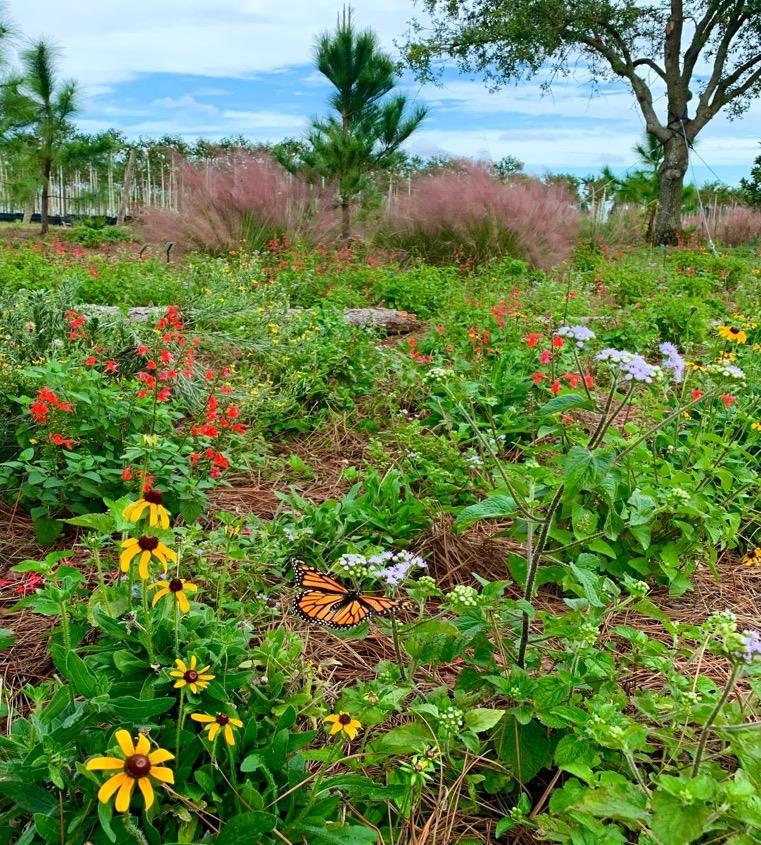
Flax Lily, VO (the bad one), Schefflera, Boxwood, Podocarpus, Liriope
White Bird of Paradise,Agave, Italian Cypress, Pittosporum, Loropetalum, Crape Myrtles, Ligustrum.
By a show of hands, who is excited about exclusively native Florida landscaping plantings?
What is working and what is not?
Where do we start?
How is it different with Natives?
How can we achieve any order in the chaos of only using Florida natives?
What styles of landscaping can we create with Florida natives?
Formal, Conventional (Status quo), Natural, Minimal?
An arboretum approach will not result in a botanical garden


